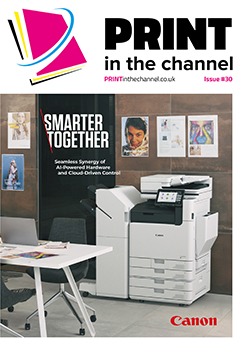With the cost of energy seemingly ever increasing, employers are looking at ways to reduce the energy their print devices consume, whether in the office or for home/hybrid workers,
and manufacturers have the solutions.
With working from home, be it part- or full-time, now the norm for significant numbers of employees, energy efficiency has become more of a priority in recent months as energy prices have rocketed and many are looking for ways to reduce their energy consumption and, with it, their bills. Many offices too are looking for efficient products as their energy bills are also on the up.
With all aspects of business – and the equipment used – under scrutiny, printers are being looked at as one of the key areas to save energy.
“Lastly, hanging on to old hardware is not cost effective. Better to invest in new printers or MFPs and benefit from all the security and productivity benefits that the latest devices offer and improve energy savings rather than sapping power consumption.”
“With the cost-of-living crisis and energy price increases having a major impact on the UK, we are seeing an acceleration in enquiries from our customers for solutions that are energy efficient, save costs and can support their organisation’s wider sustainability objectives,” says Stuart Miller, B2B indirect sales director at Canon UK & Ireland.
Steven Pearce, group head of marketing at Kyocera Document Solutions UK, agrees: “Homeworkers are concerned about their utility bills, so it’s vitally important that the products used by remote employees are energy efficient so their energy related costs are minimised.”
He adds that employers should be looking to choose devices that are designed with hybrid working in mind for their staff. “They should do the job required but include features like eco-print and Kyocera’s eco-friendly toner, which cuts power consumption by up 50% when printing the image on the page.
“Scan to the cloud is essential for hybrid workers needing to share documents easily and quickly with co-workers. We have entry level MFPs designed for this and the beauty of scanning is its inherently energy efficient as the print engine does not need to warm-up.
“It’s the balance between ecology and economy that organisations should be aiming for remote workers need to be productive while embracing more sustainable working approaches.”
Reducing energy
Deyon Antoine, product manager at Toshiba Tec, also advocates encouraging homeworkers to print to office locations via cloud printing using laptops or personal devices with print release when they attend the office. “Not only does this save on the shipping of consumables to employees’ homes and servicing costs, but this also saves on home energy costs for the employee,” he says.
There are various other strategies that employers in offices can employ to reduce energy consumption, Deyon adds. “They could rationalise their print estate by getting rid of underutilised devices, printer consolidation and where possible replace older devices with devices that support the latest environmental regulations,” he says.
“Toshiba e-STUDIO MFPs have energy saving settings, so machines can be automatically switched into energy saving mode at set times, such as after work hours, or timers can be set for the devices to enter sleep mode after use or even super sleep mode for some models, for further efficiency.
“Alternatively, employers can encourage employees to print only when is necessary and utilise digitised documents more. Or, if printing high volumes, print in off peak hours when energy is cheaper ideal for centralised print rooms.”
Energy efficient solutions
Of course, there are a range of energy efficient printers on the market. Deyon notes the need for energy efficient printers is always in manufacturers’ forethoughts when developing products. “With every new model Toshiba release we always look at ways of reducing the energy consumption of our devices,” he says. “It’s more prevalent now with the rise in energy costs, coupled with the sustainability goals businesses must be good corporate citizens, as well as targets to meet to be Net Zero. A lot of companies ask for energy consumption figures when sending out RFI’s so it’s something being asked for more and more, as it feeds into their own CSR and sustainability programmes.”
In addition, as Stuart points out, printer ranges such as Canon’s are designed to be energy efficient and reduce consumption, such as using just 0.9W in standby mode or including an auto power on and off function, which helps to reduce energy consumption if a device is left idle.
“For example, our uniFLOW Online cloud print solution supports energy savings across print infrastructures,” he says. “It helps to reduce a business’ environmental impact by optimising printing procedures and preventing unnecessary paper waste. The technology can also help to reduce power consumption by eliminating print servers that are constantly live and not in active use.
“Devices also produce significantly less CO2 compared to previous models, which is also an important consideration for buyers.”
Steven adds that this sort of thing is also being requested by public sector customers in the channel. “Schools, academies and blue light organisations not buying through frameworks are actively asking about energy efficiency because they have a responsibility to demonstrate how they are reducing their environmental impact to their stakeholders,” he says.
“This trend will continue. Sustainability is now embedded into public sector procurement and delivering local environmental priorities is just one focus of that. And as corporates home in on achieving their Net Zero targets, I believe we will see demand for energy efficient products come from smaller businesses. This in turn will drive the OEMs to develop greener products.”
He adds that Kyocera follows a ‘Reduce, Reuse, Recycle’ philosophy, which is applied at every stage of the product life cycle. “The approach is iterative, so every product is evaluated for its impact on the environment, including the use of the product by the consumer. One area that is continually examined is energy usage and how the product lowers power consumption and emission of greenhouse gases.
“It will be interesting to see how low, in terms of energy efficiency, these products can go If all manufacturers commit to introducing these processes at every stage of product development. There’s definitely an appetite for this in the industry.”
Dealer role
Dealers have an important role to play in advising customers on which energy saving devices
are right for their business and the range of benefits they provide, not just in terms of reduced energy consumption.
“They need to look at it holistically, it’s not only to do with energy efficiency but also the green benefits as both are associated with CSR,” says Deyon. “There are also things like device and print management, which help with fleet rationalisation/reduction to help reduce not only energy costs but other associated running costs.”
Deyon adds that other sustainable objectives, such as carbon neutrality, should be highlighted. “Toshiba devices are shipped to the customer as a carbon neutral product, through the Toshiba Carbon Zero Scheme, which is a key consideration for CSR and sustainability,” he says.
Stuart agrees that partners should consider highlighting traits such as power efficiency, emissions, and sustainability benefits when speaking to customers. “As well as the overall savings that can be made by procuring a device,” he says. “Resellers should also be aware that many businesses must now meet wider sustainability objectives and offer products that will help them achieve this”
Future trends
All the commentators here believe the trend for more energy efficient products will continue and that there is more scope for greater energy savings in the future.
“As the awareness of sustainability issues increase and the energy crisis continues across the UK, we expect to see this trend continuing for the long-term,” says Stuart. “We’re likely to see more organisations seeking out environmentally friendly solutions, while the demand for circular products, recycled materials and services is set to continue.”
Deyon adds that demand will grow as companies strive to meet Net Zero targets. “We will all have to invest in innovative and greener print technologies to help lower energy consumption further.”
Steve adds that the future is cloud-based platforms as more businesses seek to remove their on-premise servers to a multi-tenanted cloud space, significantly reducing energy consumption for all tenants and enabling them to securely print and scan from anywhere.
“MFPs possessing proximity sensors, which power up devices only when required and come with power-saving modes are great for reducing energy consumption in offices. What we’re really talking here is intelligent power management.
“The big thing to look for is functions such as stand-by mode, power levels and timer settings that can be set by departments. Stand-by power used during sleep mode can be less than 0.5W today, plus devices should return to ready without demanding extra power.
“Looking for Energy Star devices is a good start – it’s an environmental label we often take for granted today but it’s an assurance that a product is certified energy efficient and can save up to 35% compared to conventional printers.
“Lastly, hanging on to old hardware is not cost effective. Better to invest in new printers or MFPs and benefit from all the security and productivity benefits that the latest devices offer and improve energy savings rather than sapping power consumption.”
He adds that demand for energy saving printers is growing across the board currently, with additional demand within the public sector.
“Many have questions concerning running costs, sustainability and energy saving, but the majority are interested first and foremost in the price of devices,” he says. “With energy costs rising dramatically, businesses are more driven to research the exact financial outlay of what they are buying, as many are under significant economic strain.
“Outside of the public sector, purchasers are looking to save where possible and looking for a longer-term rather than a short-term saving. They are becoming savvier concerning the total cost of ownership when making an investment. Subsequently, the current economic environment means that while price is









